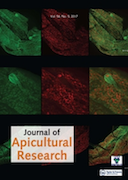Abstract
Natural honey bee products, especially propolis are well known for their biological properties. However, less well known are the impact of propolis’ single phenolic substances and variation across different landscapes, geographic locations and botanical origins. Here, we determined the chemical composition of propolis samples collected in different geographic areas of Romania with a continental climate. Main groups of polyphenols, as well as individual phenolics (phenolic acids and flavonoids), were identified and quantified. The antimicrobial activity of propolis ethanolic extracts and some of the most important propolis phenolics (caffeic and ferulic acid, pinocembrin, chrysin and galangin) were evaluated against different bacterial species.
Analyzing the interaction of bacterial growth inhibition and different chemical parameters, revealed that flavone/flavonol, flavanone/dihydroflavonol, chrysin and galangin are largely responsible for the propolis’ antimicrobial activity against Gram-positive bacteria. Gram-negative bacteria were mostly inhibited by galangin, caffeic acid and naringenin. Chemical composition and antimicrobial activity of the propolis samples might be explained by the botanical sources present in the specific foraging areas. The highest amounts of polyphenols and flavonoids were measured in regions where deciduous forests were dominant to coniferous, or where large areas of willow could be observed.
* THESE STATEMENTS HAVE NOT BEEN EVALUATED BY THE FOOD AND DRUG ADMINISTRATION. THIS IS NOT INTENDED TO DIAGNOSE, TREAT CURE OR PREVENT ANY DISEASE.
